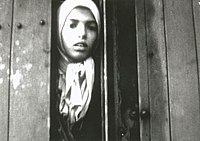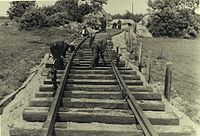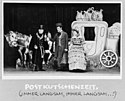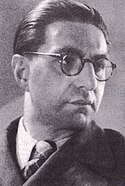Rudolf Breslauer
| Rudolf Breslauer | |
|---|---|
 | |
| Narození | 4. července 1903 Lipsko |
| Úmrtí | 28. února 1945 (ve věku 41 let) Koncentrační tábor Osvětim |
| Povolání | fotograf a filmový režisér |
| Významná díla | Westerbork movie |
| Některá data mohou pocházet z datové položky. | |
Werner Rudolf Breslauer (4. července 1903 – 28. února 1945, koncentrační tábor Osvětim) byl německý fotograf a kameraman židovského původu.
Lipsko, Nizozemsko, Westerbork, Osvětim

Breslauer se narodil v Lipsku, kde se vyučil fotografem a tiskařem. V roce 1938 uprchl do Nizozemska, kde žil a pracoval v Leidenu, Alphenu a Utrechtu.[1] V roce 1942 byli Breslauer, jeho manželka Bella Weissmann, synové Mischa a Stefan a dcera Ursula uvězněni a deportováni do tranzitního tábora Westerbork. Velitel tábora Albert Konrad Gemmeker nařídil Breslauerovi, aby pořídil dokumentační fotografie a filmy ze života lidí ve Westerborku.[2] Breslauer a jeho rodina byli transportováni do Osvětimi na podzim roku 1944.[3] Jeho manželka a dva synové byli okamžitě zabiti, Rudolf Breslauer zemřel o několik měsíců později. Jejich dcera Ursula válku přežila.
Fotografie, fotografie a film z Westerbork od Breslauera
Německý velitel tábora Albert Gemmeker nařídil Breslauerovi dokumentovat každodenní život v internačním táboře Westerbork. V roce 2017 byly tyto filmy předloženy Nizozemskem a zahrnuty do registru Paměti světa UNESCO.[4]
Galerie
Settela Steinbach, 19. května 1944
Vánoce 1942 ve Westerborku (zleva doprava) Albert Konrad Gemmeker, Hassel, Ferdinand aus der Fünten a Scheltnes of Lippmann, Rosenthal & Co.
Svátek světel Chanuka ve Westerborku
Transport do Auschwitzu (Westerborkfilm)
Kabaret 1943 kamp westerbork Postkutschenzeit
Zubní lékař v táboře Westerbork
Westerbork, škola v táboře
Westerbork, stavba železniční trati vedoucí do tábora
Westerbork, Nizozemsko, Židé nastupující na deportační vlak do Osvětimi
Westerbork, Nizozemsko, houslista a harmonikář hrající hudbu na štědrovečerní večeři
Westerbork, Nizozemsko, stavba přístřešku v areálu tábora
Westerbork, Nizozemsko, stavba železniční trati vedoucí do tábora
Odkazy
Reference
V tomto článku byl použit překlad textu z článku Rudolf Breslauer na anglické Wikipedii.
- ↑ Werner Rudolf Breslauer. Joods Monument [online]. [cit. 2021-01-17]. Dostupné online. (nizozemsky)
- ↑ Home. Nederlands Auschwitz Comité [online]. [cit. 2021-01-17]. Dostupné online.
- ↑ Rudolf Werner Breslauer. www.biografischportaal.nl [online]. [cit. 2021-01-17]. Dostupné online.
- ↑ Westerbork films [online]. United Nations Educational, Scientific and Cultural Organization [cit. 2018-10-09]. Dostupné online. (anglicky)
Externí odkazy
 Obrázky, zvuky či videa k tématu Rudolf Breslauer na Wikimedia Commons
Obrázky, zvuky či videa k tématu Rudolf Breslauer na Wikimedia Commons - Film Westerbork od Rudolfa Breslauera v roce 1944. NPO-Geschiedenis, květen 2011 (Čtyři krátké filmy a dva filmy s volnými záběry)
Média použitá na této stránce
Westerbork, a school in the camp
Transit camp for Jews, Westerbork, Second World War, Netherlands, December 1943. Photo: Hanukkah celebration (the Jewish rededication festival) in a shack in Westerbork. Leo Blumensohn, the first registered resident of the Westerbork camp, lights the menorah candlestick.
Cabaret 1943 kamp westerbork Postkutschenzeit
Tandarts Kamp Westerbork
Roma girl Settela Steinbach in the door of the train from Durchgangslager Westerbork (the Netherlands) to Konzentrationslager Auschwitz, where she was killed
Photographer Rudolf Breslauer (1903-1944)
Westerbork, Holland, a violinist and an accordionist playing music at a Christmas Eve dinner.
Album number: FA29/165 , FA29/0 Album item no: 97839
Album Title: Westerbork, Holland, 1942-1943, a personal album of camp commander Albert Konrad Gemmeker.Westerbork, Holland, Construction of a shelter on the camp grounds. FA29/98
Westerbork, Netherlands, Jews boarding a deportation train to Auschwitz. Archival signature: 0
Album number: FA29/56 , FA29/0 Album item no: 97839
Album Title: Westerbork, Holland, 1942-1943, a personal album of camp commander Albert Konrad Gemmeker.German war criminal Ferdinand aus der Fünten (1909-1989) (down right), two other SS officers (Gemmeker & Hassel) and Mr. Scheltnes. Camp Westerbork, "Yule" (near Christmas), 1942.
The Westerbork Film is from a nazi propaganda film, made in 1944 by assignment of a camp commander of the 'transit camp' Westerbork in the Netherlands. For tens of thousands of Jews, Roma and Sinti this camp was the final stop on their way to the extermination camps in Eastern Europe. With these images, made by German prisoner of Jewish decent Rudolf Breslauer, camp commander Gemmeker probably wanted to show how in control he was. The horrors of the reality behind the seemingly every day activities displayed remain unmentioned: The entire camp was a cover-up which had as its goal to lure the prisoners into a false sense of security and then to transport them across the border, heading east, towards their death.
Westerbork, Holland, Construction of railway tracks leading to the camp
Fotograaf Breslauer aan het werk als gevangene in Nazi gevangenkamp Westerbork onder bevel van SS-Obersturmführer Gemmeker - in de werkplaats waar andere dwangarbeiders vliegtuigen moesten slopen.
Westerbork, Holland, Construction of railway tracks leading to the camp.
























